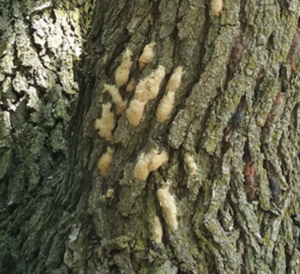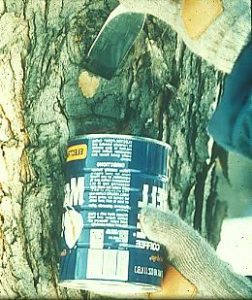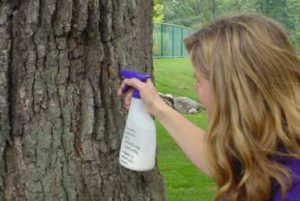By Bill McNee, DNR Forest Health Specialist, Oshkosh. bill.mcnee@wisconsin.gov; 920-360-0942

Gypsy moth egg masses. Photo: Bill McNee
Fall is an excellent time to look for and dispose of gypsy moth egg masses produced by adult moths this summer. Gypsy moth egg masses are felt-like, tan-colored patches about the size of a nickel or quarter that gypsy moth females deposit in protected places. Surveying for egg masses helps property owners predict how high populations of the insect will be during the subsequent spring and summer. Since egg masses usually don’t hatch until April, information gained from fall/winter surveys can be used to mitigate gypsy moth damage before the following season.
Removing egg masses
Gypsy moth caterpillars feed on leaves of many tree and shrub species during spring and early summer. High caterpillar populations may cause heavy tree defoliation which weakens trees, possibly killing them. Removing gypsy moth egg masses in the fall and winter helps reduce future populations.

Scraping egg masses into soapy water. Photo: Bill McNee
The best time to remove egg masses is after tree leaves drop in the fall. When egg masses are found, remove or treat those safely within reach. If only a few egg masses are found, accessible ones can be sprayed with horticultural oil (available online or at many home and garden centers), or gently scraped into a container of soapy water to soak for a few days before being discarded in the trash. Do not use motor oil or mineral oil to treat egg masses; these oils can cause damage to trees. Target “fresh” egg masses that were produced during the summer; they will feel firm and be darker tan in color than older egg masses. Masses from previous years appear faded and feel spongy. Look for egg masses on tree trunks and the undersides of branches, on buildings, in firewood piles, and on vehicles
and other outdoor objects.

Saturating egg masses with horticultural oil. Photo: Bill McNee
Other control methods
During spring and summer when gypsy moth caterpillars are active, insecticides or physical controls such as sticky barriers and burlap bands may reduce their populations.
If caterpillar populations are large, pesticide treatments may be necessary to protect vulnerable trees. For information on hiring professional arborists to conduct ground-based insecticide sprays, visit the Wisconsin Arborist Association website at http://www.waa-isa.org/arborist-for-hire/. Additional businesses that conduct insecticide treatments may be found online or in local phone books.
If egg mass surveys conducted during the fall or winter predict caterpillar damage will be severe on larger properties, landowners may wish to hire an aerial pesticide applicator. To keep costs down, neighbors sometimes band together to hire one applicator for multiple properties. A list of licensed aerial applicators is available on the DNR’s website at https://gypsymoth.wi.gov/documents/AerialApplicators.pdf.
Both ground-based and aerial pesticide applications are usually performed in late spring when caterpillars begin to feed on tree leaves. During caterpillar outbreaks, pesticide applicators are usually very busy; engaging one well in advance will help ensure availability. Woodlot owners may wish to contact a forester to discuss whether aerial spraying would be appropriate for their properties.
For information on control of gypsy moths, visit https://dnr.wi.gov/topic/forestmanagement/documents/pub/FR-405.pdf
